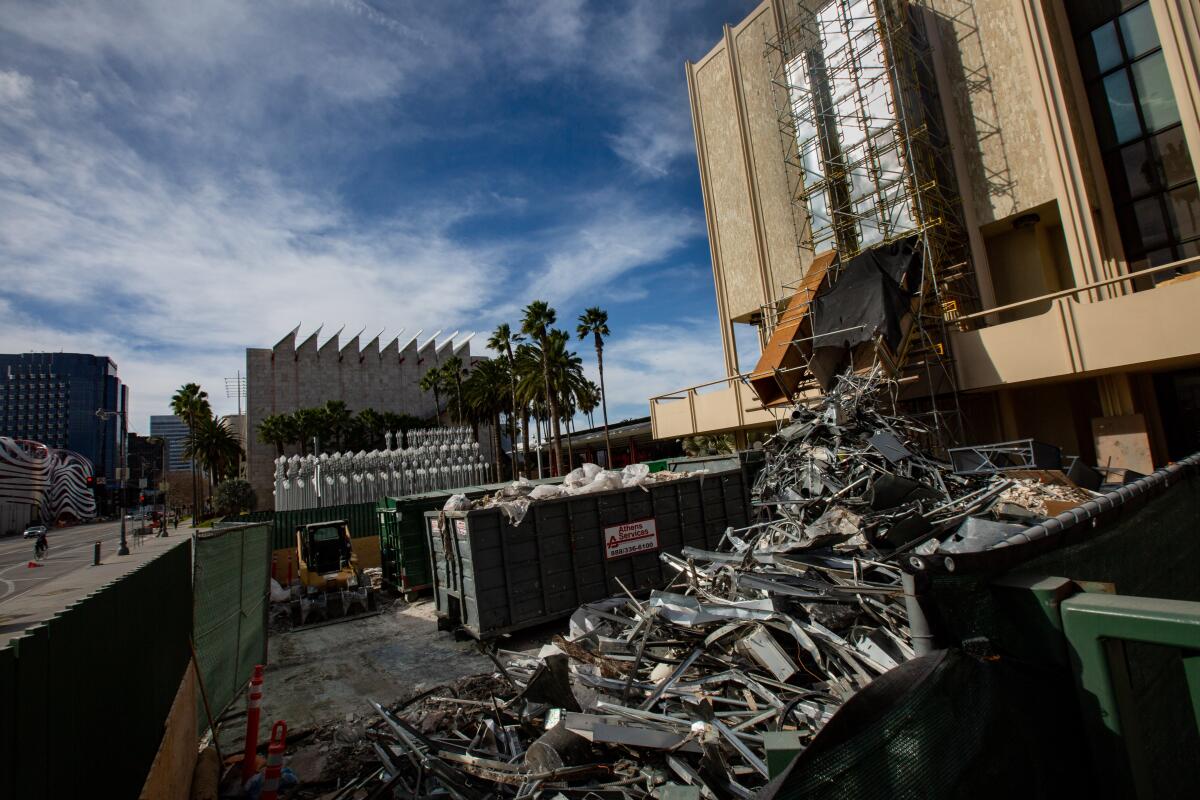LACMA wins $50 million pledge for new museum, moving a stalled campaign forward
The Los Angeles County Museum of Art has taken a major step toward building its new campus, securing a $50 million pledge toward the $750 million project and ending a fundraising drought that lasted through most of last year.
The $50 million pledge comes from the Los Angeles-based W.M. Keck Foundation, the museum confirmed to The Times on Thursday. Keck chief executive Robert A. Day is a LACMA life trustee.
The pledge raises the total commitments to $640 million. The $50 million from Keck is the second-largest private pledge to the project, after a $150 million pledge from entertainment mogul David Geffen in 2017. Casino and hotel magnate Elaine Wynn, co-chair of LACMA’s board of trustees, in 2016 also pledged $50 million. The Los Angeles County Board of Supervisors has authorized $125 million in taxpayer funds for construction of the new building.
LACMA has struggled to raise money for the project, which years ago set a $650 million fundraising goal. The proposed building, a single-story exhibition hall designed by Pritzker Prize-winning Swiss architect Peter Zumthor and named the David Geffen Galleries, would be raised on piers and would straddle Wilshire Boulevard. Four existing buildings will be demolished, and that work is scheduled to start at the end of February, the museum said.
“It’s thrilling. I am really grateful to the Keck Foundation,” LACMA Director Michael Govan said of an organization that most recently has focused on education and medical research, as well as science and engineering.
“It’s really exciting because it’s about bringing new people into philanthropy for culture.”
For the remainder of the fundraising, Govan said, the museum is turning to the public.
“It’ll be an enjoyable phase of the campaign through the building construction to engage as many people as possible to feel part of this big civic project,” he said, calling it a three-year effort.
The project, however, has faced tough public scrutiny on social media, where critics likened the design to freeway overpass rest stop and a misshapen pancake dropped on Wilshire. Opposition grew when changes in the design made the new museum 10% smaller than the previous iteration of Zumthor’s plan, with less gallery space for art than what LACMA had had in the soon-to-be demolished buildings before the Zumthor campaign launched.
The museum also has faced fundraising competition from other museums, including the nearly completed Academy Museum rising next door and an ambitious expansion at the Hammer Museum in Westwood. Skeptics also speculated that building costs were escalating as the fundraising has dragged on.
In summer 2018, LACMA had raised about $550 million. By December 2018, the campaign stood at $560 million, where it remained through most of 2019. At LACMA’s gala this past November, Govan told The Times that the campaign was “pushing $580 million.”
Although fundraising appeared largely stalled, the museum did achieve key victories. Last April the Los Angeles County Board of Supervisors voted to approve the project and release the bulk of public funding.
LACMA trustees instructed Govan to produce $75 million in new funding by the start of 2020, according to two people who have direct knowledge of the project and who requested anonymity because they were not authorized to speak. They said that figure later was dialed back to $50 million.
On Thursday, Govan characterized that scenario as “absolutely not true.”
Trustees, he said, were simply figuring out how much money they wanted in hand at the time “hard construction was beginning.”
“There were no hard deadlines,” Govan said. “These were conversations of prudence and comfort.”

The Zumthor building, like the existing Resnick Pavilion and BCAM building on the LACMA campus, does not include curatorial office space, the Balch Art Research Library, conservation studios, art storage or a photography studio. Those and other functions are being relocated to leased commercial space across the street from the museum and elsewhere in Los Angeles and are part of the project budget.
Beyond the cost and the architectural design (including its concrete walls), a change in how art will be displayed in the new museum also has generated resistance. Typically, installations of important works in an art museum’s permanent collection remain relatively fixed for a decade or more, with alterations made as scholarship develops and new acquisitions expand the institution’s overview. LACMA envisions developing thematic installations that will remain for three years or less, without fixed displays of masterpieces in the collection.
“We heard that they needed to get $50 million to begin construction,” Day said, adding that “we thought it was very important to the city of Los Angeles to be part of the new LACMA.”
LACMA’s permanent collection galleries are closed as the museum readies for construction. Its BCAM building and Resnick Pavilion buildings remain open.
LACMA aims to open the new building in 2024.
More to Read
The biggest entertainment stories
Get our big stories about Hollywood, film, television, music, arts, culture and more right in your inbox as soon as they publish.
You may occasionally receive promotional content from the Los Angeles Times.












